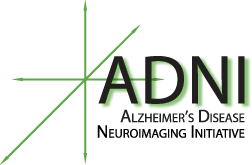ADNI has funded the following MRI core analysis labs to generate numeric summaries from the high-quality MRI data available in the data archive. Below is a summary of the MRI analysis methods. Anyone with an ADNI Data Archive account may view and download the analysis methods and the analyzed data. After logging in, click Download and Study Data to see all relevant ADNI documents available for download.
Laboratory of Neuro Imaging, USC
Diffusion Tensor Imaging Summary Statistics of White Matter Regions of Interest
Diffusion tensor imaging (DTI) allows for the study of microstructural properties of white matter tracts. Regional summary measures were calculated from DTI to include measures of diffusion and anisotropy of various fiber tracts within the brain. A standard DTI template, with a corresponding white matter tract atlas, was registered to each individual subject. Registrations were subsequently applied to the segmented atlas. Visual inspection of the images ensured adequate registration. The mean of all voxels from each of the regions of interest from the atlas were obtained from maps of fraction (FA) and mean diffusivity (MD).
Tensor-Based Morphometry Protocol
Tensor Based Morphometry (TBM) is applied to cross-sectional MRI data for local volumetric comparisons between two or more groups of subjects, based on nonlinearly registering individual brain scans to a common anatomical template. Moreover, when TBM is applied to a longitudinal MRI study, the derived Jacobian maps reflect the percentage of tissue change over time.
Center for Imaging of Neurodegenerative Diseases, UCSF
FreeSurfer Overview and Quality Control
Cortical reconstruction and volumetric segmentation is performed with the FreeSurfer image analysis suite. FreeSurfer analysis was completed using Version 4.3 for ADNI1 cross-sectional data[UCSFFSX], Version 4.4 for ADNI1 longitudinal data[UCSFFSL], and Version 5.1 for ADNI GO and 2 data[UCSFFSX51].
ASL Perfusion Processing Methods
The Center for Imaging of Neurodegenerative Diseases (CIND) processing pipeline for Arterial Spin Label (ASL) imaging, prepares perfusion-weighted images (PWI) and computes a quantitative map of cerebral blood flow (CBF) and a regional analysis.
Hippocampal Voluming Analysis
Semi-automated hippocampal volumetry was carried out using a commercially available high-dimensional brain mapping tool: Medtronic Surgical Navigation Technologies (SNT). This method of hippocampal voluming has a documented reliability of an intraclass coefficient better than .94.
Alzheimer’s Disease Center, UC Davis
Total Cranial Vault Segmentation: Method and Grading Rubric
The quality of the total cranial vault segmentation using DSE T2 weighted MRI brain scans has been verified and individually graded.
4-Tissue Segmentation Methods for ADNI MR Scans
This document describes the 4-Tissue segmentation methods used for ADNI scans to produce segmentations of each image into four tissue types: White Matter, Gray Matter, Cerebrospinal Fluid, and White Matter Hyperintensity.
Institute of Neurology, University College London
Brain and Ventricular Boundary Shift Integral
We describe the processing methods in the brain and ventricular boundary shift integral (BSI). The brain and ventricles were first semi-automatically delineated from the T1-weighted MRI scans. The repeat scans were then registered to the baseline scans using 9-degree-of-freedom registration. The intensity inhomogeneity between the baseline and registered repeat scans was corrected using the differential bias correction. Finally, BSI was calculated over the boundaries of the brain and ventricles respectively using the registered and corrected scans.
Biomedical Image Analysis, University of Pennsylvania
Spatial Patter of Abnormalities for Recognition of Early AD
The SPARE-AD score was calculated for each individual, using a specific pattern classification method. This score indicates the presence of an AD-like spatial pattern of brain atrophy, if positive, and otherwise if negative.


